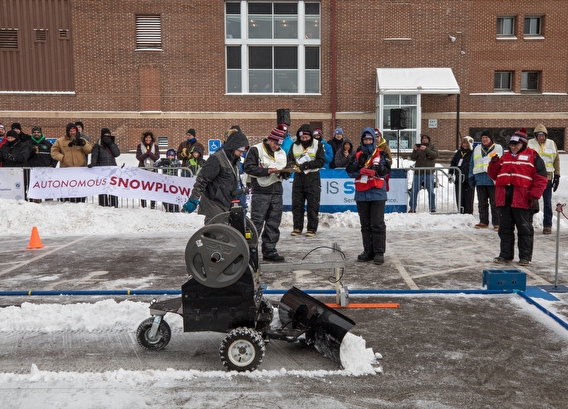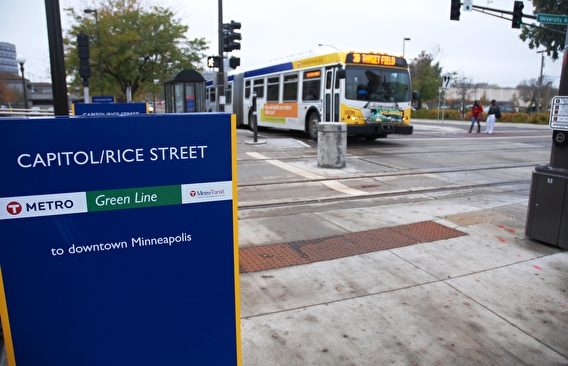
Connected and automated vehicle (CAV) technology is moving forward, with three pilot shuttle projects on tap in Minnesota this year alone. Rapid developments are leaving little time for planners and policymakers to prepare for the mainstreaming of technology and the evolution of the current transportation system—all while ensuring that transportation equity has a seat in the vehicle.
In the past several years, U of M researchers have gathered information from community members and stakeholders across the state to understand the needs of transportation-disadvantaged communities. These populations have limited access to transportation because of their level of income or ability or the extent of service in an area.
In their most recent work, the researchers focused on communities in the east metro of the Twin Cities, particularly the East Side, downtown, and Frogtown areas of St. Paul. They documented mobility challenges and explored how CAVs could change the landscape of transportation options and accessibility.
“We found a potential for CAVs to fill a constructive role,” says Frank Douma, director of state and local policy and outreach with the Institute for Urban and Regional Infrastructure Finance (IURIF) in the Humphrey School of Public Affairs and the project’s principal investigator.
Two ideas stand out as tangible ways CAVs can solve issues: by closing existing transportation gaps and by facilitating non-passenger uses.
“Study participants emphasized that compared to other parts of the Twin Cities area, there is a relative lack of transit accessibility in the east metro,” says Adeel Lari, IURIF director and the project’s co-investigator. While transit access is generally concentrated in downtown St. Paul, job growth has occurred further and further out from the urban core, causing long commutes that are not well served by transit.

One case that typifies this spatial mismatch is the limited access between the Sun Ray transit center and the Woodwinds Health campus. The area has been talked about as a CAV pilot opportunity.
“CAVs could supplement the existing transportation system to close such gaps, but it will be crucial to build in accessibility for all users,” Lari says. Strategies could include requiring an attendant on board to assist riders, ensuring that technology supports multiple languages and is visually and audibly accessible, and offering technological support for unbanked riders and riders without a smartphone.
CAVs could also be a constructive tool for non-passenger uses in the east metro. “Study participants specifically noted the use of CAV technology for maintenance and delivery as a way to increase accessibility,” Lari says.
One example is the potential for automated snowplows to clear sidewalks and bus stops. “Using CAV technology for maintenance would have tremendous potential for making multimodal infrastructure more accessible, especially during the winter months,” says study team member Kim Napoline, a former Humphrey School graduate research assistant.
Efforts to automate snow removal tools are already underway. Dunwoody College in Minneapolis hosts an annual autonomous snowplow competition that demonstrates this potential use.
Delivery service, which took on increasing importance during the pandemic, is another opportunity for CAVs in the east metro. The researchers say it will be important to focus not only on younger people adept at using today’s common apps but also on seniors and others who need groceries and prescriptions brought to their homes.
“A marketplace for essential deliveries could be formed in the east metro, building on mobility services such as Mobility4All that seniors are already using,” Lari says. Another mobility provider, NewTrax, transitioned to food distribution during the pandemic, partnering with Washington and Ramsey Counties to provide food to people in need.
Overall, the researchers say there is significant potential for CAVs to connect underserved areas to the broader metro-wide transit system, which could prove beneficial for communities and transit systems alike. They note, however, that the cost of using CAV technology is a major factor: Planners may need to consider establishing partnerships or policy interventions to avoid inequitable “tiers of access” from emerging in a CAV system.
One of the most prominent themes that surfaced in the study was the potential for CAVs to reiterate existing transportation disparities. Participants raised concerns about private manufacturers driving CAV development and emphasized that public policy must be created to encourage—or force—manufacturers to address equity issues. “Perhaps the most notable takeaway is that policy needs to take a stronger role in guiding private development to address equity issues as CAV technology develops,” Douma says.
The research will be published in the University of Michigan’s Journal of Law and Mobility. Erika Shepard, another former Humphrey School research assistant and study team member, is the lead author of the paper. She is now a multimodal planner with the Wisconsin Department of Transportation.
The research was sponsored under the Transportation Policy and Economic Competitiveness (TPEC) Program. TPEC is a joint program of IURIF and CTS.


